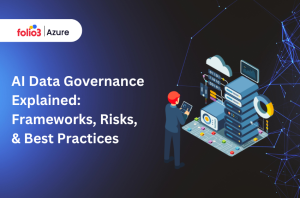Table of Contents
ToggleIn the world of data management and processing, the tools you pick can make a big difference in how well your data projects work. It’s a bit like a skilled craftsman choosing the right tools for a job – the right ones can lead to success, while the wrong ones can cause problems. In this complex field, there are two main options: Azure Data Factory and Azure Databricks.
Azure Data Factory is good at handling data and getting it organized, while Azure Databricks is great for analyzing data and using it for things like machine learning. Both of these are important tools in Microsoft’s set of data services. But as data processing becomes more complicated than ever, it’s vital to understand how these tools are different.
In this guide, we’ll take a deep dive into Azure Data Factory and Databricks. We’ll compare them so you can decide which one is right for your data needs. So, let’s get started on this journey to help you make the best choice for your data projects.
Understanding Azure Data Factory
Azure Data Factory (ADF) is Microsoft’s cloud-based data integration service that allows you to create data-driven workflows for orchestrating and automating data movement and data transformation. It’s a versatile tool that caters to a wide range of data integration scenarios. Here are some of its key benefits:
Key Benefits of Azure Data Factory
- Hybrid Data Integration: Azure Data Factory (ADF) is great at connecting data from your office computers to various cloud services. This means your data is easy to reach, and it connects your office computers to the vast cloud world securely and efficiently. It helps data move safely between different places.
- Visual Data Orchestration: ADF stands out because it offers an easy-to-use visual interface for making data workflows. This makes it simple for a wide range of people, including both developers and non-developers, to work with it. This easy access not only makes creating data pipelines easier but also encourages different teams to work together smoothly, which makes work relationships better and more efficient.
- Scalability: You can effortlessly scale ADF resources up or down to accommodate your workload requirements, which ensures cost-efficiency and effective management when handling varying data loads.
- Security and Compliance: Leveraging Azure’s comprehensive suite of robust security features, Azure Data Factory (ADF) stands as a bastion of data protection, assuring that your critical information remains secure and fully compliant with the stringent standards and regulations of your industry.
- Integration with Azure Services: Azure Data Factory, often abbreviated as ADF, seamlessly integrates with other Azure services like Azure SQL Data Warehouse, Azure Data Lake Storage, and Azure Machine Learning, providing a comprehensive and holistic data processing ecosystem.
Understanding Azure Databricks
Azure Databricks, in contrast, is a quick, user-friendly, and teamwork-friendly platform for analyzing large sets of data. It offers a workspace where you can work on big data analysis, machine learning, and data engineering. Let’s look at some of the good things about Azure Databricks.
Key Benefits of Azure Databricks
- Unified Analytics Platform: Databricks skillfully combines data engineering, data science, and advanced analytics into a unified platform, fostering seamless collaboration among teams as they work harmoniously on the same data.
- Massive Scalability: Azure Databricks is really good at handling big data tasks without any trouble. It can do this so well because it can automatically adjust to the amount of work it needs to do. This is great because it not only works well but also helps you save money because you only pay for what you actually use.
- Integration with AI: Azure Databricks works really well with Azure Machine Learning. This makes it even better for creating, testing, and using machine learning models. It’s easy to use and super efficient.
- Interactive Notebooks: Azure Databricks is a strong tool for data analysis. It offers interactive notebooks to help you explore and see data better. This makes it easier to understand data and make smart choices.
- Robust Ecosystem: Azure Databricks is really versatile because it can work with many types of data like data lakes, data warehouses, and streaming data. This means it can be used for lots of different tasks and data situations easily.
Now that we’ve extensively covered the individual strengths and capabilities of Azure Data Factory vs. Databricks, let’s delve more deeply into the key differences between these two platforms.
Key Differences Between Azure Data Factory and Azure Databricks
1. Purpose
- Azure Data Factory: Azure Data Factory, also known as ADF, is mainly made to handle all aspects of working with data. It’s really good at organizing data, making it move from one place to another smoothly, and handling complicated data tasks automatically. This helps businesses be more flexible and precise in dealing with data, which is crucial in today’s data-focused world.
- Azure Databricks: On the flip side, Azure Databricks stands out because it’s designed specifically for tasks like data analysis, machine learning, and data engineering. It provides a collaborative space with lots of useful features. It’s made for data scientists and engineers to work together and make sense of data, which helps create new ideas and useful information.
2. Ease of Use
- Azure Data Factory: Azure Data Factory (ADF) offers a user-friendly visual interface that greatly simplifies the creation of data pipelines. This makes it particularly well-suited for users who may not possess extensive coding skills or programming expertise.
- Azure Databricks: While Azure Databricks also provides a user-friendly interface, it primarily caters more comprehensively to the needs of data professionals and data scientists. It offers interactive notebooks for writing code, which not only provides greater flexibility but may also require a higher degree of technical expertise to fully harness its capabilities.
3. Data Processing
- Azure Data Factory: Azure Data Factory (ADF) specializes primarily in batch-oriented data processing. It comes into its own in scenarios where data must be meticulously moved and transformed at carefully scheduled intervals. This precision in data handling ensures that your data workflows are executed flawlessly and reliably.
- Azure Databricks: Azure Databricks is strategically designed to excel in the realm of real-time and interactive data processing. Its specialization lies in effectively handling streaming data, facilitating iterative machine-learning workflows, and providing robust support for ad-hoc analytics.
4. Coding Flexibility
- Azure Data Factory: Azure Data Factory (ADF) provides an incredibly user-friendly low-code/no-code approach to building data pipelines, effectively democratizing data integration and making it accessible to a broader range of users.
- Azure Databricks: Azure Databricks offers a broader spectrum of coding flexibility, accommodating multiple programming languages such as Python, Scala, and R. This inherent versatility proves immensely valuable, especially when dealing with intricate data transformations and the development of tailored analytics solutions.
5. Cost
- Azure Data Factory: Azure Data Factory’s pricing model is structured around the number of data movement and data transformation activities, making it a cost-effective choice, particularly for workloads that are predictable and well-defined.
- Azure Databricks: Azure Databricks’ pricing model hinges on the resources you consume, offering a considerable advantage for workloads that demand dynamic scaling. Nevertheless, if not managed meticulously, this pricing structure can potentially lead to increased costs.
Conclusion
In the comparison between Azure Data Factory and Azure Databricks, the right option depends on what you need to do with your data. If you mainly want a tool for putting together, organizing, and moving data, Azure Data Factory is a good choice. It’s straightforward and doesn’t cost too much.
But if you’re more into analyzing data, using it for machine learning, or working on data engineering, Azure Databricks is the way to go. It’s a flexible platform that can handle lots of coding. It’s excellent for tasks that need quick processing and exploring data.
In the end, both Azure Data Factory and Databricks have their strengths. The best pick depends on what your organization wants to achieve and what your team is good at. Also, think about your data pipeline needs and how much you can spend. No matter which one you decide on, Microsoft Azure has powerful tools for your data work.


